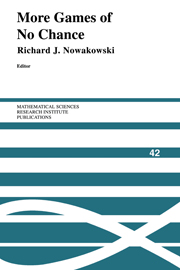Book contents
- Frontmatter
- Contents
- Preface
- The Big Picture
- Idempotents Among Partisan Games
- On the Lattice Structure of Finite Games
- More Infinite Games
- Alpha-Beta Pruning Under Partial Orders
- The Abstract Structure of the Group of Games
- The Old Classics
- Higher Nimbers in Pawn Endgames on Large Chessboards
- Restoring Fairness to Dukego
- Go Thermography: The 4/21/98 Jiang-Rui Endgame
- An Application of Mathematical Game Theory to Go Endgames: Some Width-Two-Entrance Rooms With and Without Kos
- Go Endgames Are PSPACE-Hard
- Global Threats in Combinatorial Games: A Computation Model with Applications to Chess Endgames
- The Game of Hex: The Hierarchical Approach
- Hypercube Tic-Tac-Toe
- Transfinite Chomp
- A Memory Efficient Retrograde Algorithm and Its Application to Chinese Chess Endgames
- The New Classics
- The 4G4G4G4G4 Problems and Solutions
- Experiments in Computer Amazons
- Exhaustive Search in Amazons
- Two-Player Games on Cellular Automata
- Who Wins Domineering on Rectangular Boards?
- Forcing Your Opponent to Stay in Control of a Loony Dot-and-Boxes Endgame
- 1 x n Konane: A Summary of Results
- 1-Dimensional Peg Solitaire, and Duotaire
- Phutball Endgames Are Hard
- One-Dimensional Phutball
- A Symmetric Strategy in Graph Avoidance Games
- A Simple FSM-Based Proof of the Additive Periodicity of the Sprague-Grundy Function of Wythoff's Game
- Puzzles and Life
- The Complexity of Clickomania
- Coin-Moving Puzzles
- Searching for Spaceships
- Surveys
- Unsolved Problems in Combinatorial Game Theory: Updated
- Combinatorial Games: Selected Bibliography With A Succinct Gourmet Introduction
Exhaustive Search in Amazons
Published online by Cambridge University Press: 29 May 2025
- Frontmatter
- Contents
- Preface
- The Big Picture
- Idempotents Among Partisan Games
- On the Lattice Structure of Finite Games
- More Infinite Games
- Alpha-Beta Pruning Under Partial Orders
- The Abstract Structure of the Group of Games
- The Old Classics
- Higher Nimbers in Pawn Endgames on Large Chessboards
- Restoring Fairness to Dukego
- Go Thermography: The 4/21/98 Jiang-Rui Endgame
- An Application of Mathematical Game Theory to Go Endgames: Some Width-Two-Entrance Rooms With and Without Kos
- Go Endgames Are PSPACE-Hard
- Global Threats in Combinatorial Games: A Computation Model with Applications to Chess Endgames
- The Game of Hex: The Hierarchical Approach
- Hypercube Tic-Tac-Toe
- Transfinite Chomp
- A Memory Efficient Retrograde Algorithm and Its Application to Chinese Chess Endgames
- The New Classics
- The 4G4G4G4G4 Problems and Solutions
- Experiments in Computer Amazons
- Exhaustive Search in Amazons
- Two-Player Games on Cellular Automata
- Who Wins Domineering on Rectangular Boards?
- Forcing Your Opponent to Stay in Control of a Loony Dot-and-Boxes Endgame
- 1 x n Konane: A Summary of Results
- 1-Dimensional Peg Solitaire, and Duotaire
- Phutball Endgames Are Hard
- One-Dimensional Phutball
- A Symmetric Strategy in Graph Avoidance Games
- A Simple FSM-Based Proof of the Additive Periodicity of the Sprague-Grundy Function of Wythoff's Game
- Puzzles and Life
- The Complexity of Clickomania
- Coin-Moving Puzzles
- Searching for Spaceships
- Surveys
- Unsolved Problems in Combinatorial Game Theory: Updated
- Combinatorial Games: Selected Bibliography With A Succinct Gourmet Introduction
Summary
ABSTRACT. Amazons is a young “real world” game that fulfills all defining constraints of combinatorial game theory with its original rule set. We present a program to evaluate small Amazons positions with a given number of amazons on game boards of restricted sizes with canonical combinatorial game theory values. The program does not use an analytical approach, instead it relies on exhaustive search in a bottom-up strategy. Here it is applied on all positions on game boards which fit into an underlying game board of size 11 by 2.
The results show that even under these restrictions Amazons offers a wide spread of game theoretic values, including some very interesting ones. Also the canonical forms of the values can be very complicated.
1. Introduction
“The Game of the Amazons” — or simply “Amazons” — is a relatively new star on the sky of abstract strategic two-person games, invented in 1988 by Argentinian Walter Zamkauskas. Compared with other non-classical games it seems to be well done — easy rules, many interesting choices for each move, a big range of different tactics and strategies to employ, challenging even after many games played. It has yet to prove if it can stand the comparison to classics like chess and go.
Amazons has already built a solid base of players and followers. It has especially produced interest in programmers, leading to several Amazons programming competitions including a yearly world-championship and a tournament at the Mind Sports Olympiad 2000, see for example [Iida and Müller 2000] and [Hensgens and Uiterwijk 2000]. Already there are about a dozen different Amazons programs competing at these tournaments. Some of these programs play strong enough to beat average human players easily.
In contrast to most games of this type combinatorial game theory can be applied directly to Amazons without any changes to the rules. Amazons also often decomposes into at least two independent subgames when the endgame is played out, making the application of combinatorial game theory worthwhile.
The first analysis of Amazons with the means of combinatorial game theory was done by E. Berlekamp, who looked at positions with one amazon per player on boards of size 2 by n [Berlekamp 2000]. Berlekamp calculated only the thermographs for these positions, but even these proved to be quite difficult to analyze.
Information
- Type
- Chapter
- Information
- More Games of No Chance , pp. 261 - 278Publisher: Cambridge University PressPrint publication year: 2002
Accessibility standard: Unknown
Why this information is here
This section outlines the accessibility features of this content - including support for screen readers, full keyboard navigation and high-contrast display options. This may not be relevant for you.Accessibility Information
- 1
- Cited by
